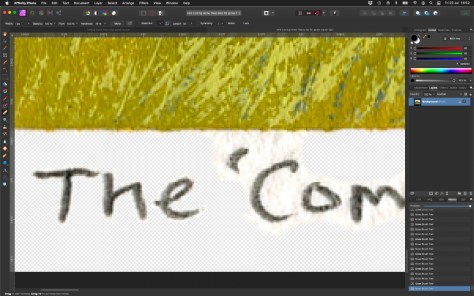I’ve never been one to make New Year’s resolutions. I’m far too easily distracted. Just one small spark and I’m off diving down another rabbit hole. That said, and this might be the seasonal surfeit of whisky and Drambuie talking, I’ve come to a decision: in 2023 I’m going to concentrate my artistic efforts on Lino printing.
I had an enjoyable dabble a few years back and even got as far as investing in a fabulous Gunning Etching Press No. 1 in readiness for the flood of prints I’d be making… but I never truly applied myself and just carried on painting instead. I’ve been good at talking myself out of giving it a proper go ever since.
One reason I love painting in watercolour and gouache is because it’s pretty much instant, sort of. Get inspired, slop some paint about, job done. Next. I like that.
In contrast Lino printing takes meticulous planning, a sharp mind able to untangle mirrored designs across multiple colour layers and oodles of time. That’s a level of mental gymnastics and determination I’m not sure I possess as over the years both my patience and ability to focus have diminished.
The sharpest tool in the Lino printing box…
And something else has been blocking me. I’ve been dreading sharpening my nice shiny set of Pfeil cutters. What can I say? They’re pretty expensive and I’m ham-fisted, what could possibly go wrong? I know, I know, I’ve just got to buckle up and learn. My tools will become blunt and I will have to sharpen them. Still going to make me sweat though…
All the gear, no idea
So, I’ve got everything I need, cutters, sharpening stones, a strop, Lino, paper, ink and a press. The choice of subject for my first ‘serious’ go at printing might come as a surprise. Ideally I should choose something simple, take baby steps first. A straightforward design in a single colour would fit the bill. That’s what I should do…
…which is why I’ve decided to try my hand at a multi-layer reduction print. A reduction print is one where the design is transferred to a single block of Lino which is then cut away in successive stages. Each stage becomes a separate colour layer on the finished print. Not simple at all then.
Not only that, I want to try using soft colours which graduate one into the other. Again, not the best place for a beginner to start. But I’m going to do it anyway. If I’m going to get stuck in then I prefer to do something really challenging and learn from my mistakes.
A familiar subject
For my first subject I’ve chosen one of my older paintings of the Old Lifeboat Station at Lizard Point, Cornwall. Now I’ve no intention of trying to slavishly recreate this painting as a print, but I do like the composition and misty atmosphere. Initially I’m thinking of no more than 4 layers which increase in tone from light to dark. However, that might be too ambitious and once I start to cut the Lino and get ink on paper I might change my mind…

You’ll see from these progress photos that I’ve already started planning my first cuts. These will become areas of bare white paper on the final print, highlights; the sparkles on the sea. One thing I’ll need to get to grips with learn early on is how the oil-based Caligo Safewash inks mix with each other, their reducer which thins them and the drying gel which speed up the drying process.



Lino printing isn’t going to be an easy journey but it will be interesting to see what progress I’ll have made by this time next year.
For regular updates please follow me on Facebook, Instagram or Twitter.














































